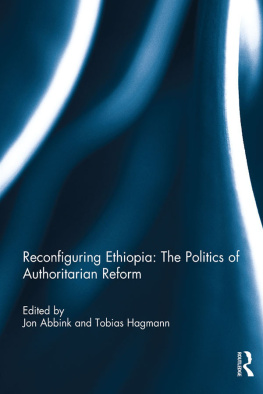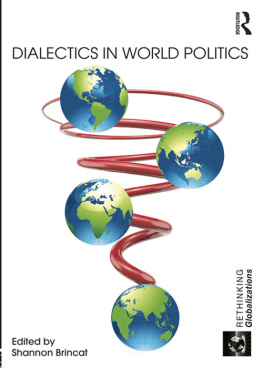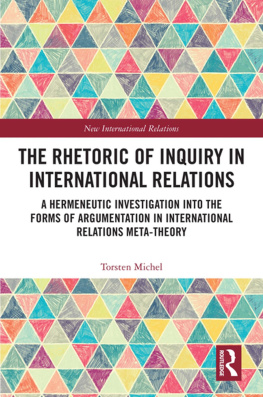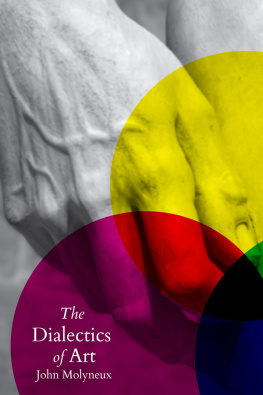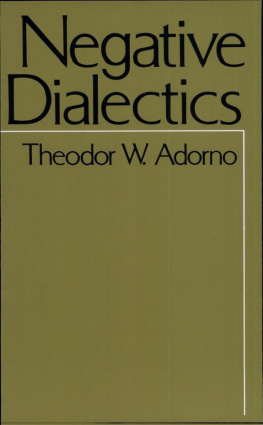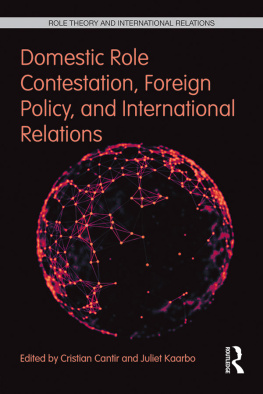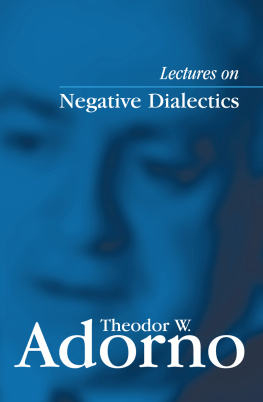RHETORIC AND SOCIAL RELATIONS
Studies in Rhetoric and Culture
Series Editors:
Ivo Strecker, Johannes Gutenberg University Mainz
Robert Hariman, Northwestern University
Felix Girke, University of Konstanz
Christian Meyer, University of Konstanz
Our minds are filled with images and ideas, but these remain unstable and incomplete as long as we do not manage to persuade both ourselves and others of their meanings. It is this inward and outward rhetoric which allows us to give some kind of shape and structure to our understanding of the world and which becomes central to the formation of individual and collective consciousness. This series is dedicated to the study of the interaction of rhetoric and culture and focuses on the concrete practices of discourse in which and through which the diverse and often also fantastic patterns of culture including our own are created, maintained and contested.
Volume 8
Rhetoric and Social Relations: Dialectics of Bonding and Contestation
Edited by Jon Abbink and Shauna LaTosky
Volume 7
Culture, Catastrophe and Rhetoric: The Texture of Political Action
Edited by Robert Hariman and Ralph Cintron
Volume 6
Chiasmus and Culture
Edited by Boris Wiseman and Anthony Paul
Volume 5
Astonishment and Evocation: The Spell of Culture in Art and Anthropology
Edited by Ivo Strecker and Markus Verne
Volume 4
The Rhetorical Emergence of Culture
Edited by Christian Meyer and Felix Girke
Volume 3
Economic Persuasions
Edited by Stephen Gudeman
Volume 2
Culture, Rhetoric and the Vicissitudes of Life
Edited by Michael Carrithers
Volume 1
Culture and Rhetoric
Edited by Ivo Strecker and Stephen Tyler
RHETORIC AND SOCIAL RELATIONS
DIALECTICS OF BONDING AND CONTESTATION
Edited by
JON ABBINK AND SHAUNA LATOSKY
First published in 2021 by
Berghahn Books
www.berghahnbooks.com
2021 Jon Abbink and Shauna LaTosky
All rights reserved. Except for the quotation of short passages for the purposes of criticism and review, no part of this book may be reproduced in any form or by any means, electronic or mechanical, including photocopying, recording, or any information storage and retrieval system now known or to be invented, without written permission of the publisher.
Library of Congress Cataloging-in-Publication Data
Names: Abbink, J., editor. | LaTosky, Shauna, editor.
Title: Rhetoric and social relations : dialectics of bonding and contestation / edited by Jon Abbink and Shauna LaTosky.
Description: First edition. | New York : Berghahn Books, 2021. | Series: Studies in rhetoric and culture ; 8 | Includes bibliographical references and index.
Identifiers: LCCN 2020042370 (print) | LCCN 2020042371 (ebook) | ISBN 9781789209778 (hardback) | ISBN 9781789209785 (ebook)
Subjects: LCSH: RhetoricSocial aspects.
Classification: LCC P301.5.S63 R483 2021 (print) | LCC P301.5.S63 (ebook) | DDC 306.44dc23
LC record available at https://lccn.loc.gov/2020042370
LC ebook record available at https://lccn.loc.gov/2020042371
British Library Cataloguing in Publication Data
A catalogue record for this book is available from the British Library
ISBN 978-1-78920-977-8 hardback
ISBN 978-1-78920-978-5 ebook
ILLUSTRATIONS
FIGURES
MAP
TABLES
PREFACE
Jon Abbink and Shauna LaTosky
This book on rhetoric and social relations completes the basic edifice of the Rhetoric and Culture series, initiated with I. Strecker and S. Tylers volume Culture and Rhetoric (2009). Together, the eight books set in motion a compelling exploration of the complex and chiasmic nature of culture and rhetoric. We are grateful to the authors in this volume for their contributions and their patience, and also to the series editors for their inspiration and encouragement.
In line with admonitions from various authors within the Rhetoric Culture Project on the importance of ethnography and comparison, this volume contains chapters that are almost all based on serious fieldwork, which they see as crucial to test and extend the scope of the assumptions and hypotheses of the Rhetoric Culture Project. We wholeheartedly agree with Boris Wiseman when he says in his chapter Chiastic Thought and Culture in volume 1 of the series (p. 87) that the ethnographic application of rhetoric to non-Western societies places rhetoric in a new set of discursive and social relations. Such a process implies a dissolution of rhetoric (in its familiar guises) and its reassemblage in another context. This is not to contend that rhetoric in Western and non-Western societies is in any essential way different, but that there is a need to thoroughly assess sociocultural contexts and to examine how forms of human sociality are reproduced and impact on rhetoric expression as a common feature of all humans. As is evident from the two main parts in this book, we frame rhetoric in social relations in the double aspect of bonding and contestation, in order to explicate our idea of a dialectic of bonding and contestation as productive tension that sustains and constrains social relations and which is closely linked to chiasmus, a core idea used in the Rhetoric Culture Project. It is a figurative, cognitive and comparative tool as well as a mode of ethnographic reflection (Wiseman, as quoted above), as heuristically and theoretically important, as Jamin Pelkeys chapter in this volume makes abundantly clear.
We hope that the rich case studies in this book illustrate the point and provide further food for thought on both empirical variety and theoretical elaboration of the rhetoric culture approach.
Finally, we are very grateful to the two anonymous reviewers of the manuscript, who provided us with pertinent and useful critical comments allowing us to improve the chapters presented here.
PART I
POSITIONING
INTRODUCTION
RHETORIC IN SOCIAL RELATIONS
Jon Abbink and Shauna LaTosky
I bless the sacred powers of persuasion
That makes calm the storm in the body
The presence of God in persuasion
Draws the poison fangs of evil
Undoes the knotted mess of brooding evil
In the gentle combat of persuasion
Good wins over good with goodness
And none lose.
Athena, in Aeschylus, The Eumenides
This volume presents a series of reflections and empirical case studies on a central, if not


